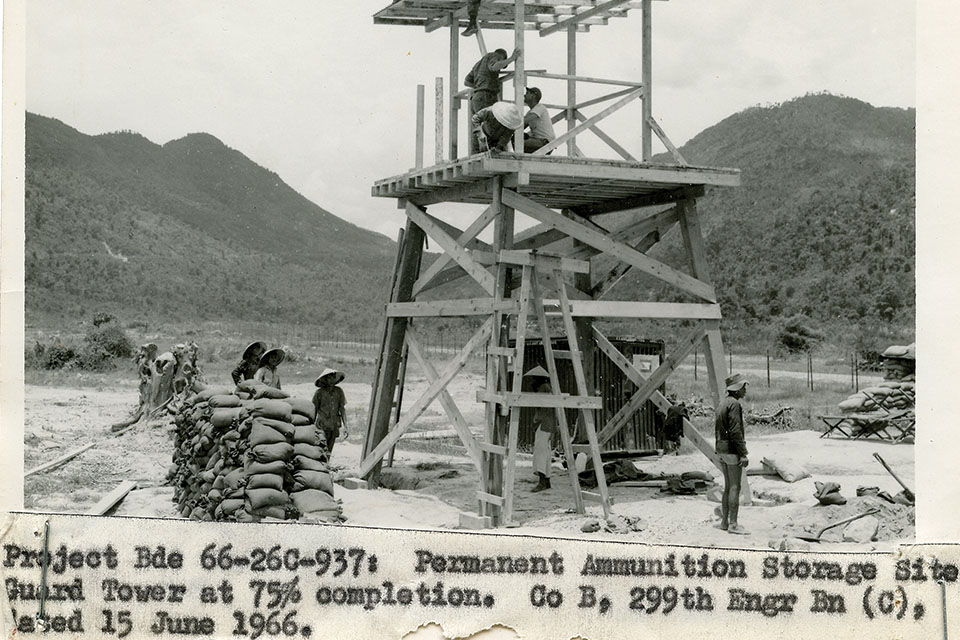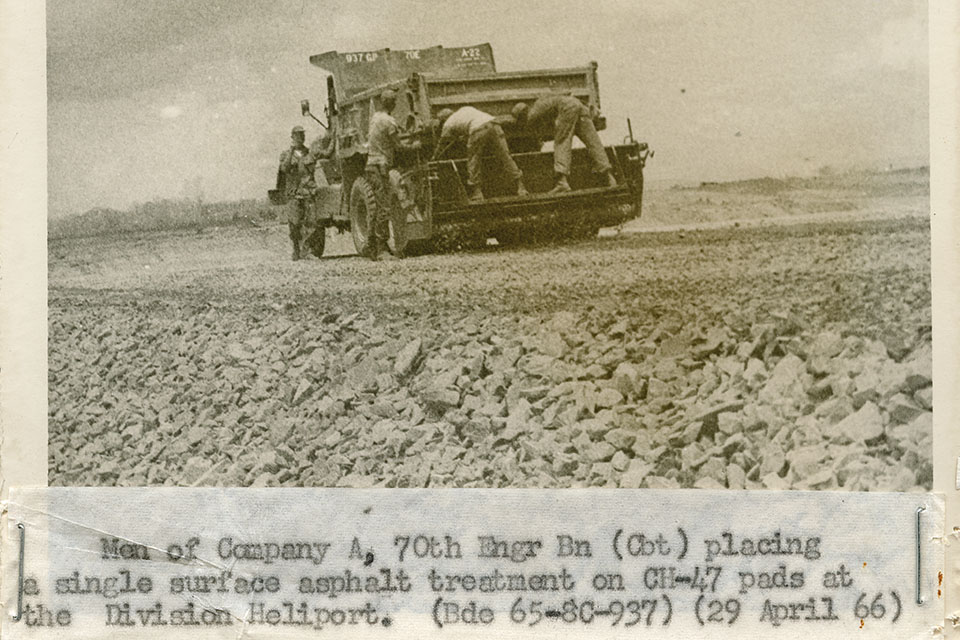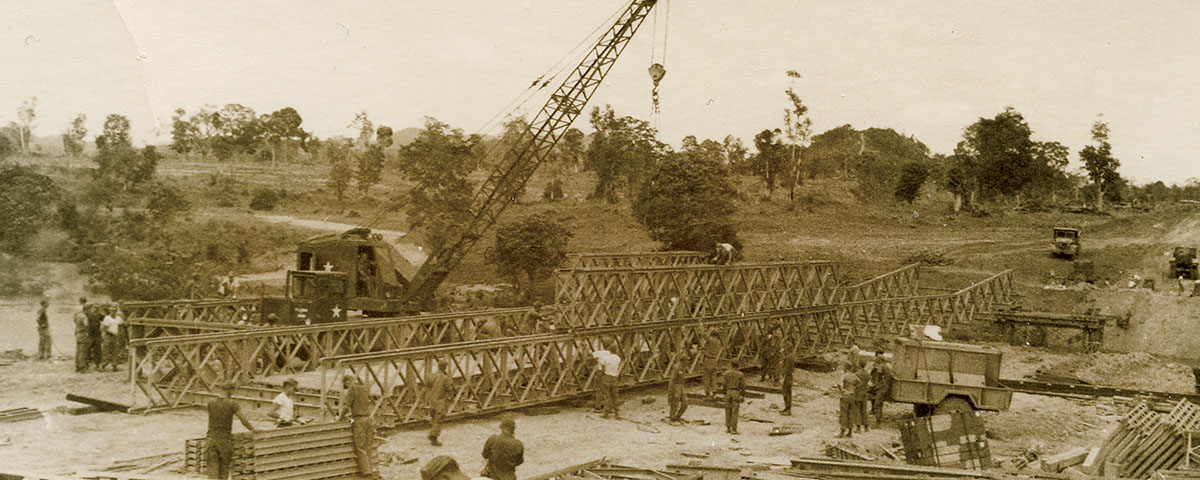Combat engineers in Vietnam: the first year
Correspondents who covered the Vietnam War typically concentrated on the more glamorous branches of the combat arms—infantry, armor and artillery. Too often unfairly ignored in the box-score statistics that measured success in countless combat operations were the accomplishments of the combat engineers who made that success possible.
An army can’t go very far without roads, bridges, runways, landing pads, ports, fuel tanks, supply depots, ammo dumps, fortifications and other critical facilities that support its operations. That’s where my unit and other battalions of the 937th Engineer Group (Combat) contributed.
As captain of C Company, 19th Engineer Battalion (Combat), stationed at Fort Meade, Maryland, I was in a classroom with the approximately 150 men in my unit watching President Lyndon B. Johnson announce during his July 28, 1965, news conference that he was sending more combat troops to Vietnam to make the world safe from communism. All of my men suddenly stood and cheered loudly because we were so proud to be among those chosen for this important mission.
Shortly afterward, we flew from Baltimore to Oakland, California, boarded the World War II troop carrier USS General W. H. Gordon, sailed 17 days to South Vietnam and made an amphibious landing in August 1965 at Qui Nhon, in the central section of South Vietnam, about 400 miles north of Saigon.
Several weeks later we handed out beer to Marines who came ashore at Qui Nhon and moved inland. The Marine landing made the front page of The New York Times and other newspapers, but there was no mention of the Army engineers who were already in the area and able to provide the leathernecks with important liquid refreshments.
During the first year of the war—following the initial Marine landing at Da Nang in March 1965—fully 75 percent of U.S. ground operations took place in central South Vietnam, from the coastal east to the highlands in the west, a region the U.S. military called the II Corps Tactical Zone.
The 937th Engineer Group was assigned to II Corps by the 18th Engineer Brigade, Command Headquarters, in Saigon. The 937th consisted of three combat battalions (the 19th, 70th and 299th), one construction battalion (the 84th) and several attached companies, including the 509th (Panel Bridge), the 511th (Panel Bridge), the 362nd (Light Equipment) and the 630th (Light Equipment), as well as one platoon of the 497th Company (Port Construction).
On paper, this assignment looked good. The 937th Engineer Group was the only combat engineer group in Vietnam, and it was being assigned to the action area. Its mission was to support the infantry by building fortifications, laying and removing mines, and constructing roads, bridges and heliports.
But things did not turn out that way. Even though the 937th received its full share of combat support missions—mainly with elements of the 1st Cavalry Division (Airmobile), 25th Infantry Division and the South Korean Capital “Tiger” Infantry Division—the group also found itself working on projects normally reserved for construction units. Combat engineer battalions were not organized or equipped to perform large-scale and sophisticated construction projects, but construction units were in short supply in Vietnam because the Army at first didn’t think there would be a great need for them.
Around September 1965, a general visited the construction site where my C Company was building a 112,000-gallon petroleum tank farm near Qui Nhon. He made it clear to me that in a few months the U.S. military would be in Hanoi. At that time, there was no official restriction on crossing the 17th parallel, the boundary between North and South Vietnam, and the 12-month limit for a tour of duty had not yet been established. We were there to win the war against communism quickly, and moving ground forces into North Vietnam would accomplish that goal. Therefore, military planning in early 1965 did not anticipate the need for major construction in South Vietnam’s central region because ground operations would just pass through there on a fast march north to Hanoi. Of course, that did not happen.
In early 1966, when I was the 937th Engineer Group’s assistant operations officer, the 18th Engineer Brigade in Saigon notified me that Defense Secretary Robert McNamara wanted an estimated cost for building a fence all around South Vietnam to keep the “bad guys” out. I dutifully prepared a cost estimate for II Corps and sent it to the 18th Engineer Brigade. Common sense prevailed, and the fence was never built.
As the war wore on, the number of construction battalions increased, but in the first year much of the basic construction work was performed by the combat engineers. The primary mission of the 937th Engineer Group was to provide base development for arriving combat units and storage facilities for the large logistics center being built at Qui Nhon.
The 84th Construction Engineer Battalion, which had been in Qui Nhon since June 1965, worked on port development, and by October a floating dock and causeway were completed, enabling vessels to unload some 800 tons of cargo a day from coastal freighters and tankers anchored offshore. By the following March, the Qui Nhon logistics depot and additional port facilities were largely completed, and the amount of cargo rapidly rose past 2,000 tons per day.

The 19th Combat Engineer Battalion developed 20 miles of roads and a 25-unit permanent heliport near Qui Nhon in preparation for the arrival of South Korea’s Tiger Division, which would be quartered in the area. We also constructed a bridge over a branch of the Song Ba river not far from Qui Nhon in November 1965 for use by the Korean troops.
The approximately 80-foot span connected two piers we had built. We fabricated it with steel components left over from a bridge that was built when Vietnam was a French colony and constructed in the style of bridges designed by Gustave Eiffel, famous for his tower in Paris. Our completed span was put into place by the coordinated pulling of at least 50 engineers and a bulldozer and then secured on the two piers. After we posted the notice of a 30-ton weight limit, the bridge was opened for traffic.
Incredibly, the bridge built by C Company men had a life span of only 30 minutes. After the opening, our battalion commander, Lt. Col. Amos Matthews, was leaving the bridge by jeep and encountered a large Army flatbed truck heading toward the bridge. Matthews told the truck’s driver that his load was way too heavy for the bridge. “Do not go over the bridge,” the colonel said.
The enlisted man disobeyed his order and proceeded to drive over our new bridge. Standing on the far side, I watched our bridge collapse into the river and the truck go down with it. I jumped into the river to pull the driver out of the cab. At that moment Matthews drove up in his jeep and looked down at me standing in the Song Ba tributary with water up to my neck. He said, “Captain Willard, build another bridge and this one with intermediate support.” I said, “Yes, sir,” rendered the hand salute, and that is exactly what we did. The bridge most likely is still standing today. (Matthews pursued disciplinary action against the driver through the commander of his unit.)
In October 1965, both the 299th Combat Engineer Battalion and the monsoon rains arrived. The 299th was tasked with hacking and clearing a 1-mile-square area for an ammunition storage depot in the jungle south of Qui Nhon. Considering the conditions, it was remarkable that 10 ammunition storage pads were operational by February 1966. When a brigade of the 25th Infantry Division arrived in January 1966, one company of the 299th was diverted to Pleiku to help set up a base there. The company also assisted with construction of the Pleiku Logistics Depot, nearby Camp Holloway and an 80-bed hospital.
Normally, building a base hospital is the lot of construction engineers, but since there weren’t any available, the task went to combat engineers, including members of the 70th Combat Engineer Battalion, sent to An Khe in August 1965 to prepare a base for the 1st Air Cav. During the first few months after the division’s arrival in the fall of 1965, the cavalrymen suffered more than 100 casualties a week, and the field hospital in An Khe was soon overwhelmed. More hospital space was needed, so the 70th Battalion constructed a 200-bed facility for the 2nd Mobile Army Surgical Hospital at the base. Additionally, elements of the 84th Battalion went on 24-hour shifts to build the 540-bed 85th Evacuation Hospital at Qui Nhon.
At An Khe, the 70th Battalion was involved in construction of an estimated 17 miles of perimeter security lighting, a depot, 60 guard towers with searchlights, a division headquarters and administration buildings, an underground command post for directing battlefield operations (20 feet by 75 feet with no intermediate supports), a heliport and a temporary airfield for C-130 transport planes. Later, two companies from the 84th Battalion went to An Khe. They constructed a 30-ton ice plant, a central telephone office and a permanent asphalt airfield.
The 1st Cavalry Division, which pioneered the airmobile concept of transporting troops to the battlefield in helicopters, could reach any point in the II Corps region from An Khe in less than 30 minutes by chopper. But in the months before construction of the asphalt airfield, the 1st Cav was becoming less and less airmobile because Vietnamese dust—a lot closer in size to sand than powder—literally sandblasted a chopper’s rotor blades, a problem that had to be solved and couldn’t wait until the asphalt arrived.
When the combat engineers were preparing for the 1st Air Cav’s arrival at An Khe, they had cleared more than 100 acres of vegetation by hand, using axes, chain saws and other tools to preserve the natural sod where helicopters would be parked. The 19th Battalion sent a special contingent to help the 70th Battalion with this massive undertaking.
The fuel and oil spillage from the helicopters, however, deteriorated the sod, which then was washed away by the swirling air generated from the rotor blades, turning the ground beneath the choppers into the destructive dust. In about three months, the green hills found at An Khe when the Cavalry units arrived, then dubbed “the golf course,” had become “the sand trap.”
Helicopter blades gave out months before their expected expiration date, and dust-clogged engines had to be overhauled twice as frequently as anticipated. In short, the helicopter’s life expectancy was cut in half.
The dust problem was not entirely unexpected because the 1st Air Cav ran into the same situation during training at Fort Benning, Georgia. Even so, the division’s planners felt the choppers could operate temporarily from outlying bases during operations there and preserve the life expectancy of the sod at the An Khe headquarters. But the division soon discovered that the “dust-free” period, when the helicopters were away from An Khe, was just a few days at a time.
I believe that U.S. planners never envisioned a prolonged stay at An Khe because they thought military operations would shift quickly to North Vietnam. The unexpected high level of combat operations in II Corps resulted in a much greater use of An Khe, and thus the natural sod gave out much sooner.
The dust problem became the No. 1 headache for the 937th Engineer Group. It caused havoc at all bases, creating safety hazards for vehicle operations and sanitary hazards for personnel. Further complicating dustproofing measures were different types of soils in different areas.
A team of soil experts was sent to Vietnam in spring 1966 by the U.S. Army’s chief of engineers to find some answers. After an exhaustive study, the team concluded that the only permanent solution was to bury all roads, bases and helicopter pads under asphalt or concrete. That was impractical in the short term. However, several stopgap measures were proposed. All enjoyed some degree of success. Among them:
• T-17 membrane. Two-ply, neoprene plastic sections 66 by 100 feet were glued together to form the membrane, which proved particularly successful in the fine orange clay conditions prevalent in the low, rolling hills around Pleiku. The stress of C-130 aircraft, however, proved too much for the membrane, which required continuous maintenance.
• Peneprime. An MC-30 asphalt cutback (asphalt blended with petroleum) that includes several chemical additives, peneprime partially met the requirements of heliports and airfields in the laterite-type soils (containing large amounts of aluminum and iron) around An Khe. It was less successful in standing up to the stress on road surfaces.
The lack of gravel and crushed stone presented a major problem for soil stabilization, concrete production and asphalt work. With only one construction battalion, the 937th Engineer Group simply did not have enough organic rock crushers to produce aggregate in sufficient quantity to meet the demand.
Additional machines were eventually sent to Vietnam from the States, and a small amount of hand-crushed rock made by Vietnamese laborers could be purchased locally (at less cost than that produced by 937th Engineer Group’s crushers), but the shortage of aggregate persisted throughout the war. In Pleiku, for example, most of the rock outcrops were too hard for the crushers to handle. Attempts to set up efficient operations at quarry sites proved too costly and time-consuming.
Equipment issues also hampered the 937th Engineer Group’s earth-moving activities when they shifted into high gear in the early months of 1966. The 937th’s machinery was considered too light to get the job done. Commanders recommended a modification in the unit’s standard equipment list to give combat engineer battalions an improved earth-moving capability.

As spring 1966 arrived and the monsoon season ebbed, U.S. military operations moved into the offensive phase, and most of the 937th’s engineers returned to their more familiar combat support roles. Heavy emphasis was placed on the construction, rehabilitation and expansion of air bases and small heliports. Bridge construction also increased.
In early 1966, I was ordered to reorganize C Company, 19th Combat Engineer Battalion, as an infantry unit and be prepared to move out with a 30-minute notice to reinforce 1st Air Cav soldiers who were countering an attack by the North Vietnamese Army at the Phu Bai Airfield. We outfitted our 5-ton dump trucks with M60 machine guns placed on sandbagged boards over the top of cab, put on armor vests and helmets, and gathered M16 rifles, ammunition and hand grenades. We were ready to go. But the order never came.
However, in 1967 and early 1968, after I had left Vietnam, the entire battalion reorganized as an infantry battalion and made an amphibious assault landing north of Qui Nhon to retake the Bong Son Bridge on Highway 1, which had been captured by the NVA. A number of soldiers were killed in the operation. In 1970, at Fort Belvoir in Virginia, I saw the captain who had replaced me as commander and he showed me a souvenir of the battle—a bullet hole in his chest.
By May 1966, the 19th Battalion had completed most of its work building the mammoth petroleum tank farm begun the previous September near Qui Nhon. Two 4-inch underwater pipelines were installed by the 497th Port Construction Platoon. And by early June, the first T2 oil tanker anchored off Qui Nhon was unloading directly into the storage tanks.
The 937th Engineer Group estimated that by late spring 1966 it was serving about 60,000 American and South Korean troops in Vietnam. It was impossible for the group to fully support that many troops, so a “self-help program” was created. Under this program, personnel of all branches of the Army and Air Force provided the final assembly touches to structures designed and prefabricated by battalions of 937th. Administration buildings, mess halls, billets, bunkers, latrines, water towers and storage sheds began springing up rapidly from Qui Nhon to Pleiku.
Late spring also highlighted other accomplishments of 937th engineers. The 299th Battalion completed most of its work on the Qui Nhon ammunition storage depot and was reassigned to Pleiku to support a brigade of the 4th Infantry Division that had just arrived in Vietnam. The 19th Battalion received the additional mission of constructing a 6,000-man maintenance area 7 miles west of Qui Nhon just off Highway 19 and a post exchange facility at Qui Nhon itself.
When the 937th Engineer Group’s first year in Vietnam ended in August 1966, the unit’s operations had an estimated cost of more than $40 million in construction materials alone. But the most amazing fact to come out of that first year of operation is that the magnitude, type and high quality of the construction was not accomplished primarily by construction battalions with their sophisticated equipment, but by the initiative and ingenuity of the soldiers of the combat engineer battalions.
[hr]
Retired Army Lt. Col. William B. Willard Jr. served in Vietnam as commanding officer of C Company, 19th Engineer Battalion (Combat), and later as assistant operations officer, 937th Engineer Group (Combat).
Willard volunteered for a second tour and served as engineer staff officer, U.S. Army Engineer Construction Agency Vietnam at Long Binh, involved in managing the massive road and bridge construction program, or LOC, “lines of communication.”
He was at Long Binh during the attack by the Viet Cong in February 1969 (“Attack on Long Binh” by Jim Van Eldik, https://www.historynet.com/attack-long-binh.htm).
A member of Willard’s staff, Spc. 5 Allen Kaizuka, was on duty in a guard tower during the attack and used his M60 machine gun to kill more than 100 Viet Cong as they attempted to come through the fence. Kaizuka received the Bronze Star for his vital defense of the Long Binh perimeter. One of Willard’s lieutenants on duty in the office during the attack leaned over to obtain a drink from the water cooler and was hit in the buttocks by a bullet, which earned him the Purple Heart.





